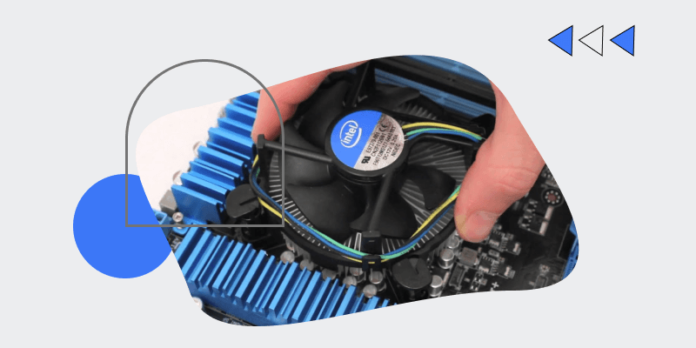Computers are designed in such a way to meet everyone’s needs. Computers are complex gadgets and therefore require effective maintenance to meet the desired results. CPU, as we all know, is the power hub of the computer, therefore, to save the circuitry from heat damage it is extremely important to install a heat sink. A heatsink is a pervasive component, which is why its presence is overlooked by people who do not know much about technology and how it works.
What is a heat sink?
A heat sink is basically a heat exchanger which is used to transfer heat away from the heat-generating device (mechanical or electrical) with the help of a fluid medium, mainly air.
In simple words, a heatsink is a component that is used to increase the heat flow away from the heated device. This can be done by increasing the temperature and the surface area. Heat sinks aesthetics, multitudes, abilities, and designs depend on the device’s configuration.
How Does a Heat Sink Works?
As maintained earlier, it diverts heat away from the heat-generating device. It takes every heat sink to accomplish this task, 4 steps.
- Heat is generated: Source generates heat, CPU starts working and when every component is being used heat is generated, the removal of heat is necessary for them to work perfectly.
- Heat is diverted away from the source: In passive heat sinks, heat is directly transferred into the heat sinks with the help of natural conditions. The thermal conductivity, of the material from which the heat sink is engineered, greatly impacts the process.
- Heat is thoroughly distributed: Heat will directly move into the heat sink via the natural phenomenon of heating travelling from a high-temperature environment to a lower temperature environment.
- Heat is removed from the heat sink: This process relies on the temperature fluid and gradient. The fluid passes across the working surface and via natural conduction absorbs heat and transfers it to the more desirable environment. This step is highly impacted by temperature gradient if the environment is not cool enough there will be no removal of heat.
Types of Heat Sinks
Active Heat Sinks: these types of heat sinks use forced air to increase fluid flow across the surface area, the forced air is generated with the help of a blower or a fan, sometimes even with the excessive movement of the object such as motorbikes engines being cooled by the help of air passing along the heart sink. The fan forces air to move across the heatsink which enables more colour liquid to travel within the device which in return helps in effective absorption and removal of hot air from the device. The extruded heat sinks and skived fin heat sinks that are usually used in the computers or CPU assembly are active heat sinks, they always come with the fans that generate airflow to improve the heat dissipation.
Passive Heat Sinks: these heat sinks rely on the natural convection of heat, meaning that the buoyancy of the air creates airflow across the system. This is the most advantageous heat sink because they do not require another system to be installed for removing the heat. However, they are less effective than active heat sinks.
Hybrid Heat sinks: As the name itself speaks, Hybrid heat sinks are a combination of both active and passive heat sinks. These types of heat sinks require control systems to cool the system. If the system is at a cooler temperature, then the forced air function will remain inactive and the passive system will be used to remove the heat. If the temperature of the source will reach the maximum level, then the active system will be used to increase the cooling capacity of the heat sink system.
How to install a heat sink and CPU
Installing your own PC:
There are some computer geeks who like to build themselves an entire system according to their needs. And if you are building a brain yourself you need to know that it must be fit and compatible with its motherboard.
Once you have gotten your hands on the desired chip you will have to start working on the rig. Setting up your own PC is not a hard job you just need some basic tools.
Earth yourself before you begin working on the fixing part, you should unplug your PC from the switch. All your components for PC come in anti-static bags, so you should make sure that there must not be any direct contact of any component with the bare surface. Prep yourself and place your components on the wooden board. Wear shoes and cotton fabric. Synthetic wool or any other synthetic fabric must be at any cost be avoided.
Installation
- The processor socket on the motherboard must be located after hat open the socket by lifting the lever
- The keyed part of the processor must be located, it is indicated by a diagonal pinned corner. The processor and the socket must be aligned.
- Once you are sure that both are aligned then you should lower the CPU in such a way that all the pins connect to the correct holes.
- Make sure that the CPU is locked
- If your processor comes with a cooling solution align it according to the description given
- Thermal fluid must be applied to the exposed parts of the processor, it must not exceed the amount of the rice grain. Thermal paste is vital for effective heat transferring from the system to the heat sink. Thermal paste is basically applied to avoid any kind of formation of air pockets. These air pockets can lead to circuitry damage in the long run. It must not, as mentioned earlier, exceed the size of a rice grain because too much wrapping can put the motherboard at risk.
Installing Heat Sink
- To install the heat sink you need to clamp the heat sink using a proper mounting technique. You can achieve this by lifting the tab over the mounting clip, or by simply screwing the heat sink over the motherboard. You need to be very cautious; a lot of pressure can damage the motherboard.
- Locate the power lead for the cooling solutions fan and fan header of the CPU on the motherboard. The plug of the power header must then be connected with the cooling fan. It must be keyed but still double-check for securing it properly.
Your personalised CPU is installed,
Conclusion
Who does not want to personalise their CPU according to their own requirements? It is not a hard task to install a heat sink or a CPU, it only requires extra care, a little bit of technique and some reference articles.








